Risk Management in Seaports: A Community Analysis at the Port of Hamburg
Abstract
1. Introduction
2. Literature Review
2.1. Seaports and Their Stakeholders
2.2. Risk Management
2.3. Network Structure and Community Detection
2.4. Related Work
3. Materials and Methods
3.1. Survey Data
3.2. Communication Intensity Values
3.3. Network Analysis
3.4. Community Detection
3.5. Plausibility Check
4. Results and Discussion
4.1. Survey Data and Descriptive Analysis
4.2. Network Analysis
4.2.1. Natural Disasters
4.2.2. Operational and Safety Risks
4.2.3. Network Parameters
4.3. Community Detection
4.3.1. Natural Disasters
4.3.2. Operational and Safety Risks
4.4. Plausibility Check
5. Implications
6. Conclusions, Limitations and Outlook
Author Contributions
Funding
Institutional Review Board Statement
Informed Consent Statement
Data Availability Statement
Acknowledgments
Conflicts of Interest
References
- Gharehgozli, A.H.; Roy, D.; de Koster, R. Sea container terminals: New technologies and OR models. Marit. Econ. Logist. 2016, 18, 103–140. [Google Scholar] [CrossRef]
- Reagans, R.; McEvily, B. Network structure and knowledge transfer: The effects of cohesion and range. Adm. Sci. Q. 2003, 48, 240–267. [Google Scholar] [CrossRef]
- Lazer, D.; Friedman, A. The network structure of exploration and exploittation. Adm. Sci. Q. 2007, 52, 667–694. [Google Scholar] [CrossRef]
- Pileggi, S.F.; Indorf, M.; Nagi, A.; Kersten, W. CoRiMaS—An Ontological Approach to Cooperative Risk Management in Seaports. Sustainability 2020, 12, 4767. [Google Scholar] [CrossRef]
- Hoyle, B.S.S. Seaports and Development: The Experience of Kenya and Tanzania; Taylor Francis: Hoboken, NJ, USA, 2012. [Google Scholar]
- Goss, R.O. Economic policies and seaports. The economic functions of seaports. Marit. Policy Manag. 1990, 17, 207–219. [Google Scholar] [CrossRef]
- De, A.; Choudhary, A.; Turkay, M.; Tiwari, M.K. Bunkering policies for a fuel bunker management problem for liner shipping networks. Eur. J. Oper. Res. 2021, 289, 927–939. [Google Scholar] [CrossRef]
- De, A.; Pratap, S.; Kumar, A.; Tiwari, M.K. A hybrid dynamic berth allocation planning problem with fuel costs considerations for container terminal port using chemical reaction optimization approach. Ann. Oper. Res. 2020, 290, 783–811. [Google Scholar] [CrossRef]
- De, A.; Wang, J.; Tiwari, M.K. Hybridizing Basic Variable Neighborhood Search with Particle Swarm Optimization for Solving Sustainable Ship Routing and Bunker Management Problem. IEEE Trans. Intell. Transp. Syst. 2020, 21, 986–997. [Google Scholar] [CrossRef]
- De, A.; Wang, J.; Tiwari, M.K. Fuel Bunker Management Strategies within Sustainable Container Shipping Operation Considering Disruption and Recovery Policies. IEEE Trans. Eng. Manag. 2021, 68, 1089–1111. [Google Scholar] [CrossRef]
- Wagner, N. Identification of the most important sustainability topics in seaports. Logist. Transp. 2017, 34, 79–88. [Google Scholar]
- Matusiewicz, M.; Rolbiecki, R. The tendency of city stakeholders to implement sustainable logistics measures using the port city of Gdynia as an example. Zesz. Nauk. Akad. Morska Szczec. 2021. Available online: https://repository.am.szczecin.pl/handle/123456789/2666 (accessed on 15 July 2021).
- Notteboom, T.; Winkelmans, W. Stakeholders relations management in ports: Dealing with the interplay of forces among stakeholders in a changing competitive environment. In Proceedings of the IAME 2002—International Association of Maritime Economists Annual Conference 2002, Panama City, Panama, 12–15 November 2002. [Google Scholar]
- Nagi, A.; Indorf, M.; Singer-Neumann, C.; Ojala, L. Current State of Risk Assessment in Seaports: An Empirical Study. In Logistik im Wandel der Zeit—Von der Produktionssteuerung zu Vernetzten Supply Chains; Springer: Berlin/Heidelberg, Germany, 2019; pp. 79–101. [Google Scholar]
- John, A.; Yang, Z.; Riahi, R.; Wang, J. A risk assessment approach to improve the resilience of a seaport system using Bayesian networks. Ocean Eng. 2016, 111, 136–147. [Google Scholar] [CrossRef]
- Schmidt, J.; Matcham, I.; Reese, S.; King, A.; Bell, R.; Henderson, R.; Smart, G.; Cousins, J.; Smith, W.; Heron, D. Quantitative multi-risk analysis for natural hazards: A framework for multi-risk modelling. Nat. Hazards 2011, 58, 1169–1192. [Google Scholar] [CrossRef]
- Kaundinya, I.; Nisancioglu, S.; Kammerer, H.; Oliva, R. All-hazard guide for transport infrastructure. Transp. Res. Procedia 2016, 14, 1325–1334. [Google Scholar] [CrossRef][Green Version]
- John, A.; Paraskevadakis, D.; Bury, A.; Yang, Z.; Riahi, R.; Wang, J. An integrated fuzzy risk assessment for seaport operations. Saf. Sci. 2014, 68, 180–194. [Google Scholar] [CrossRef]
- Loh, H.S.; Thai, V.V. Management of disruptions by seaports: Preliminary findings. Asia Pac. J. Mark. Logist. 2015, 27, 146–162. [Google Scholar] [CrossRef]
- Zhang, Y.; Lam, J.S.L. Estimating economic losses of industry clusters due to port disruptions. Transp. Res. Part A Policy Pract. 2016, 91, 17–33. [Google Scholar] [CrossRef]
- Lam, J.S.L.; Su, S. Disruption risks and mitigation strategies: An analysis of Asian ports. Marit. Policy Manag. 2015, 42, 415–435. [Google Scholar] [CrossRef]
- Hopkin, P. Fundamentals of Risk Management: Understanding, Evaluating and Implementing Effective Risk Management, 5th ed.; Kogan Page Limited: London, UK, 2018. [Google Scholar]
- Garvey, P.R. Analytical Methods for Risk Management: A Systems Engineering Perspective; CRC Press: Boca Raton, FL, USA, 2008. [Google Scholar]
- Müssigmann, N. Mitigating risk during strategic supply network modelling. In Managing Risks in Supply Chains: How to Build Reliable Collaboration in Logistics; Schmidt: Berlin/Heidelberg, Germany, 2006; pp. 213–226. [Google Scholar]
- IRGC. IRGC Guidelines for Emerging Risk Governance. 2015. Available online: https://infoscience.epfl.ch/record/228053/files/Guidelines%20for%20Emerging%20Risk%20Governance.pdf?version=1 (accessed on 15 September 2020).
- Aven, T.; Renn, O. Risk Management and Governance: Concepts, Guidelines and Applications; Springer: Berlin/Heidelberg, Germany, 2010. [Google Scholar]
- Börner, K.; Sanyal, S.; Vespignani, A. Network science. Annu. Rev. Inf. Sci. Technol. 2007, 41, 537–607. [Google Scholar] [CrossRef]
- Barabási, A.L. Network Science; Bell Bain Ltd.: Glasgow, UK, 2016. [Google Scholar]
- Achrol, R. Changes in the theory of interorganizational relations in marketing: Toward a network paradigm. J. Acad. Mark. Sci. 1996, 25, 56–71. [Google Scholar] [CrossRef]
- Estrada, E. Network Science: Complexity in Nature and Technology; Springer: London, UK, 2010. [Google Scholar]
- Seufert, A.; Krogh, G.; von Bach, A. Towards knowledge networking. J. Knowl. Manag. 1999, 3, 180–190. [Google Scholar] [CrossRef]
- Lewis, T.G. Network Science: Theory and Applications; John Wiley Sons: Hoboken, NJ, USA, 2011. [Google Scholar]
- Newman, M.E.J. Modularity and community structure in networks. Proc. Natl. Acad. Sci. USA 2006, 103, 8577–8582. [Google Scholar] [CrossRef]
- Newman, M.E.J.; Girvan, M. Finding and evaluating community structure in networks. Phys. Rev. E 2004, 69, 26113. [Google Scholar] [CrossRef]
- Cherifi, H. Complex Networks and Their Applications; Cambridge Scholars Publishing: Newcastle upon Tyne, UK, 2014. [Google Scholar]
- Aerts, G.; Dooms, M.; Haezendonck, E. Stakeholder management practices found in landlord seaport authorities in Flanders: An inside-out perspective. Int. J. Shipp. Transp. Logist. 2015, 7, 597–620. [Google Scholar] [CrossRef]
- Becker, A.H.; Matson, P.; Fischer, M.; Mastrandrea, M.D. Towards seaport resilience for climate change adaptation: Stakeholder perceptions of hurricane impacts in Gulfport (MS) and Providence (RI). Prog. Plan. 2015, 99, 1–49. [Google Scholar] [CrossRef]
- Da Cruz, M.R.P.; Ferreira, J.J.; Azevedo, S.G. Key factors of seaport competitiveness based on the stakeholder perspective: An Analytic Hierarchy Process (AHP) model. Marit. Econ. Logist. 2013, 15, 416–443. [Google Scholar] [CrossRef]
- Dooms, M.; Macharis, C.; Verbeke, A. Proactive stakeholder management in the port planning process: Empirical evidence from the Port of Brussels. Comput. Rev. 2004, 1–34. Available online: http://hdl.handle.net/10419/117092 (accessed on 15 July 2021).
- Creswell, J.W.; Plano Clark, V.L. Designing and Conducting Mixed Methods Research, 3rd ed.; Sage Publications: Thousand Oaks, CA, USA, 2018. [Google Scholar]
- Clark-Ginsberg, A. Participatory risk network analysis: A tool for disaster reduction practitioners. Int. J. Disaster Risk Reduct. 2017, 21, 430–437. [Google Scholar] [CrossRef]
- Nuss, P.; Graedel, T.E.; Alonso, E.; Carroll, A. Mapping supply chain risk by network analysis of product platforms. Sustain. Mater. Technol. 2016, 10, 14–22. [Google Scholar] [CrossRef]
- Thirumalai, C.; Sree, K.S.; Gannu, H. Analysis of cost estimation function for facebook web click data. Int. Conf. Electron. Commun. Aerosp. Technol. 2017, 2, 172–175. [Google Scholar]
- Zedan, S.; Miller, W. Using social network analysis to identify stakeholders’ influence on energy efficiency of housing. Int. J. Eng. Bus. Manag. 2017, 9, 1–11. [Google Scholar] [CrossRef]
- Jacomy, M.; Venturini, T.; Heymann, S.; Bastian, M. ForceAtlas2, a continuous graph layout algorithm for handy network visualization designed for the Gephi software. PLoS ONE 2014, 9, e98679. [Google Scholar] [CrossRef] [PubMed]
- Freeman, L.C.; Roeder, D.; Mulholland, R.R. Centrality in Social Networks II: Experimental Results; School of Social Sciences, University of California: Irvine, CA, USA, 1979. [Google Scholar]
- Rowley, T. Moving beyond dyadic ties: A network theory of stakeholder influences. Acad. Manag. Rev. 1997, 22, 887–910. [Google Scholar] [CrossRef]
- Chen, H.; Yang, C.C. Intelligence and Security Informatics. In Proceedings of the IEEE ISI 2008 International Workshops: PAISI, PACCF, and SOCO 2008, Taipei, Taiwan, 17 June 2008; Springer: Berlin/Heidelberg, Germany, 2008. [Google Scholar]
- Khokhar, D. Gephi Cookbook; Pakt Publishing Ltd.: Birmingham, BI, USA, 2015. [Google Scholar]
- Cherven, K. Mastering Gephi Network Visualization; Packt Publishing Ltd.: Birmingham, BI, USA, 2015. [Google Scholar]
- Rahiminejad, S.; Maurya, M.R.; Subramaniam, S. Topological and functional comparison of community detection algorithms in biological networks. BMC Bioinform. 2019, 20, 212. [Google Scholar] [CrossRef]
- Schink, T.; Garbe, E. Assessment of the representativity of in-patient hospital diagnoses in the German Pharmacoepidemiological Research Database. Das Gesundh. 2010, 72, P10. [Google Scholar] [CrossRef]
- Hsieh, H.-F.; Shannon, S.E. Three approaches to qualitative content analysis. Qual. Health Res. 2005, 15, 1277–1288. [Google Scholar] [CrossRef] [PubMed]
- Zarghami, S.A.; Gunawan, I. A domain-specific measure of centrality for water distribution networks. Eng. Constr. Archit. Manag. 2020, 27, 341–355. [Google Scholar] [CrossRef]
- Nacher, J.C.; Schwartz, J.-M. A global view of drug-therapy interactions. BMC Pharmacol. 2008, 8, 5. [Google Scholar] [CrossRef] [PubMed]
- Zaabi, H.A.; Bashir, H. Analyzing interdependencies in a project portfolio using social network analysis metrics. In Proceedings of the 2018 5th International Conference on Industrial Engineering and Applications (ICIEA), Singapore, 26–28 April 2018; pp. 490–494. [Google Scholar]
- Nagi, A.; Porten, H.; Indorf, M.; Kersten, W.; Bazaras, D.; Purre, A.H.; Harteela, M.; Elonen, A. Current Status of Risk Management Process at Major Baltic Sea Region Seaports. In Publications of the Hazard Project; University of Turku: Turku, Finland, 2019. [Google Scholar] [CrossRef]
- Behörde für Inneres und Sport. Wie ist der Sturmflutschutz Organisiert? 2019. Available online: https://www.hamburg.de/innenbehoerde/sturmflut/3423026/sturmflut-organisation/ (accessed on 15 September 2019).
- German Statutory Accident Insurance (DGUV). Sicheres und Gesundes Arbeiten auf Werften. 2019. Available online: www.dguv.de/de/mediencenter/pm/presse-archiv/2019/quartal_1/details_1_355174.js (accessed on 10 November 2020).
- Abendblatt. Harburg und Die Schiffe 100 Jahre Werftgeschichte. 2019. Available online: www.abendblatt.de/regionalausgaben/article227148419/Harburg-und-die-Schiffe-100-Jahre-Werftgeschichte.htm (accessed on 12 October 2020).
- Walsham, G. Actor-Network Theory and IS Research: Current Status and Future Prospects. In Information Systems and Qualitative Research; Springer: Berlin/Heidelberg, Germany, 1997; pp. 466–480. [Google Scholar]
- Goswami, M.; Daultani, Y.; De, A. Decision modeling and analysis in new product development considering supply chain uncertainties: A multi-functional expert based approach. Expert Syst. Appl. 2021, 166, 114016. [Google Scholar] [CrossRef]
- Choudhary, A.; De, A.; Ahmed, K.; Shankar, R. An integrated fuzzy intuitionistic sustainability assessment framework for manufacturing supply chain: A study of UK based firms. Ann. Oper. Res. 2021. [Google Scholar] [CrossRef]


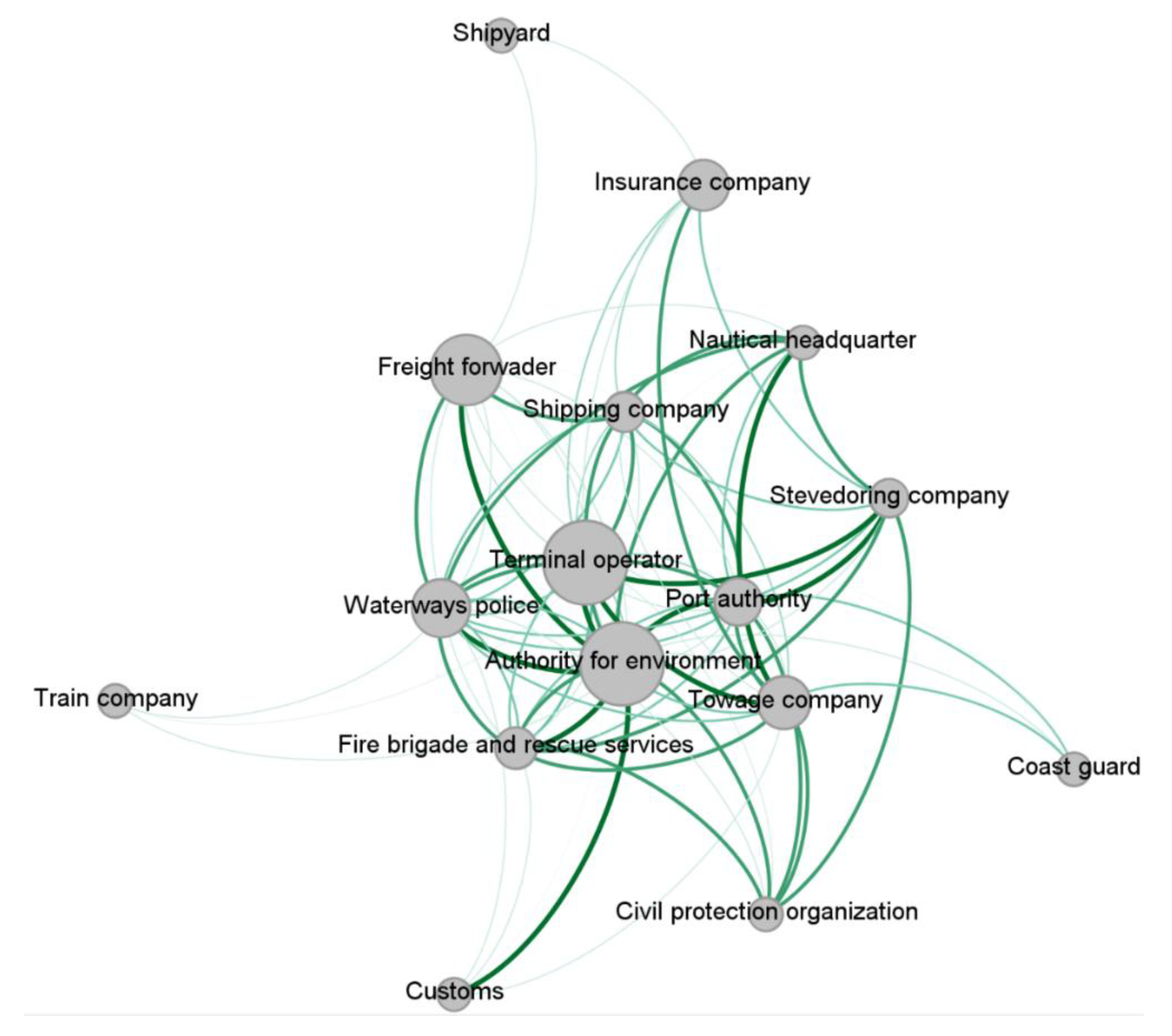
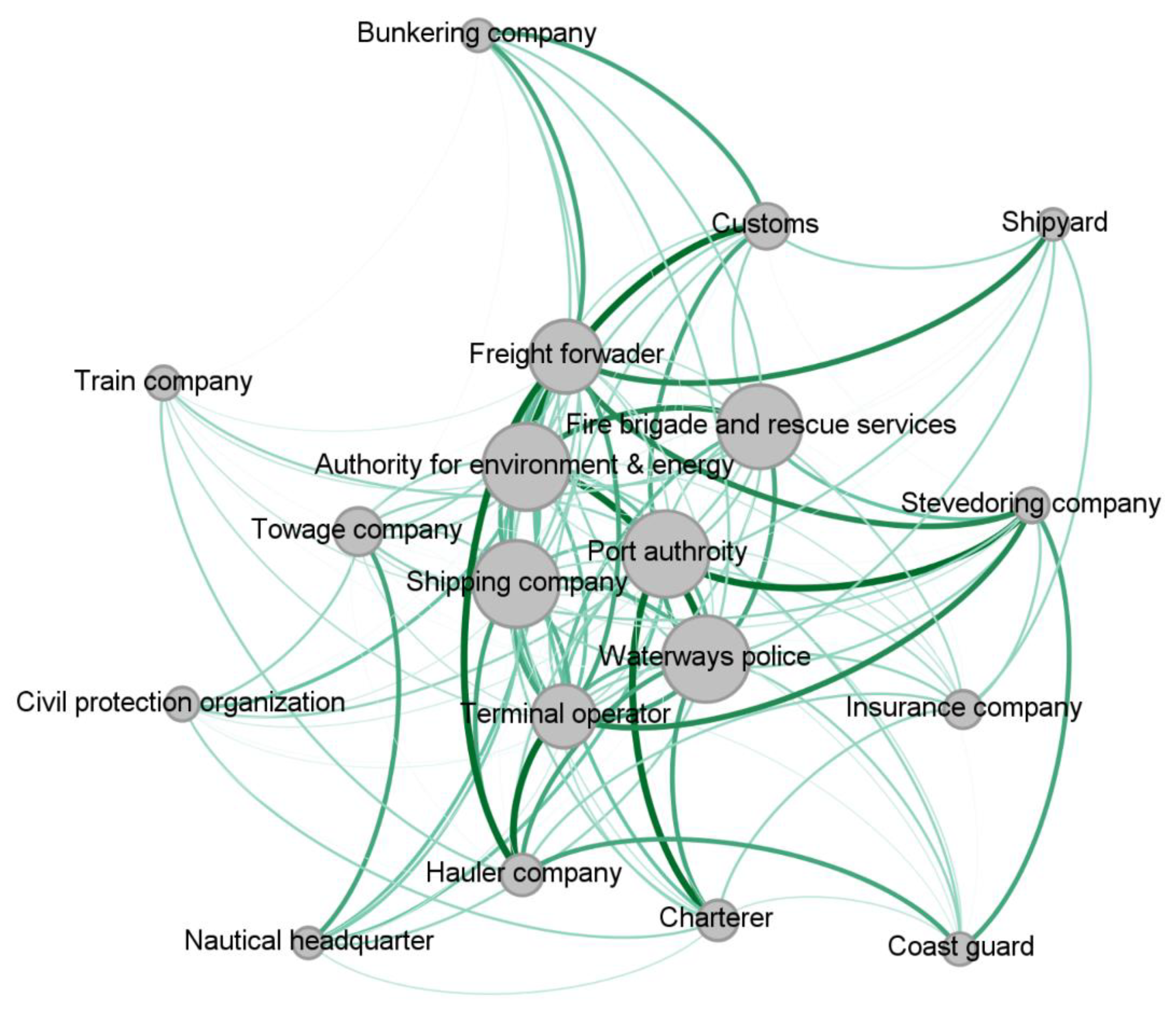
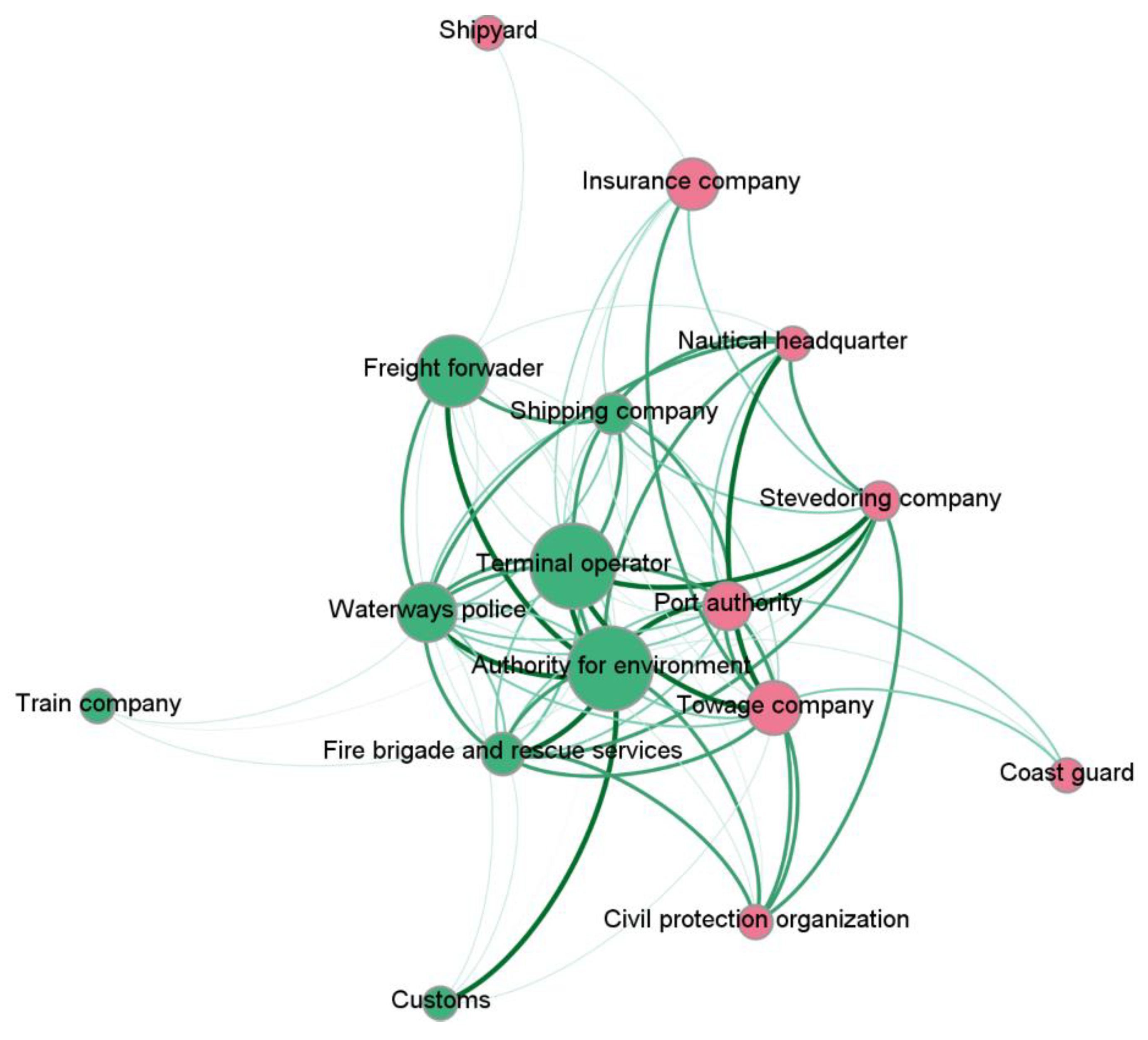
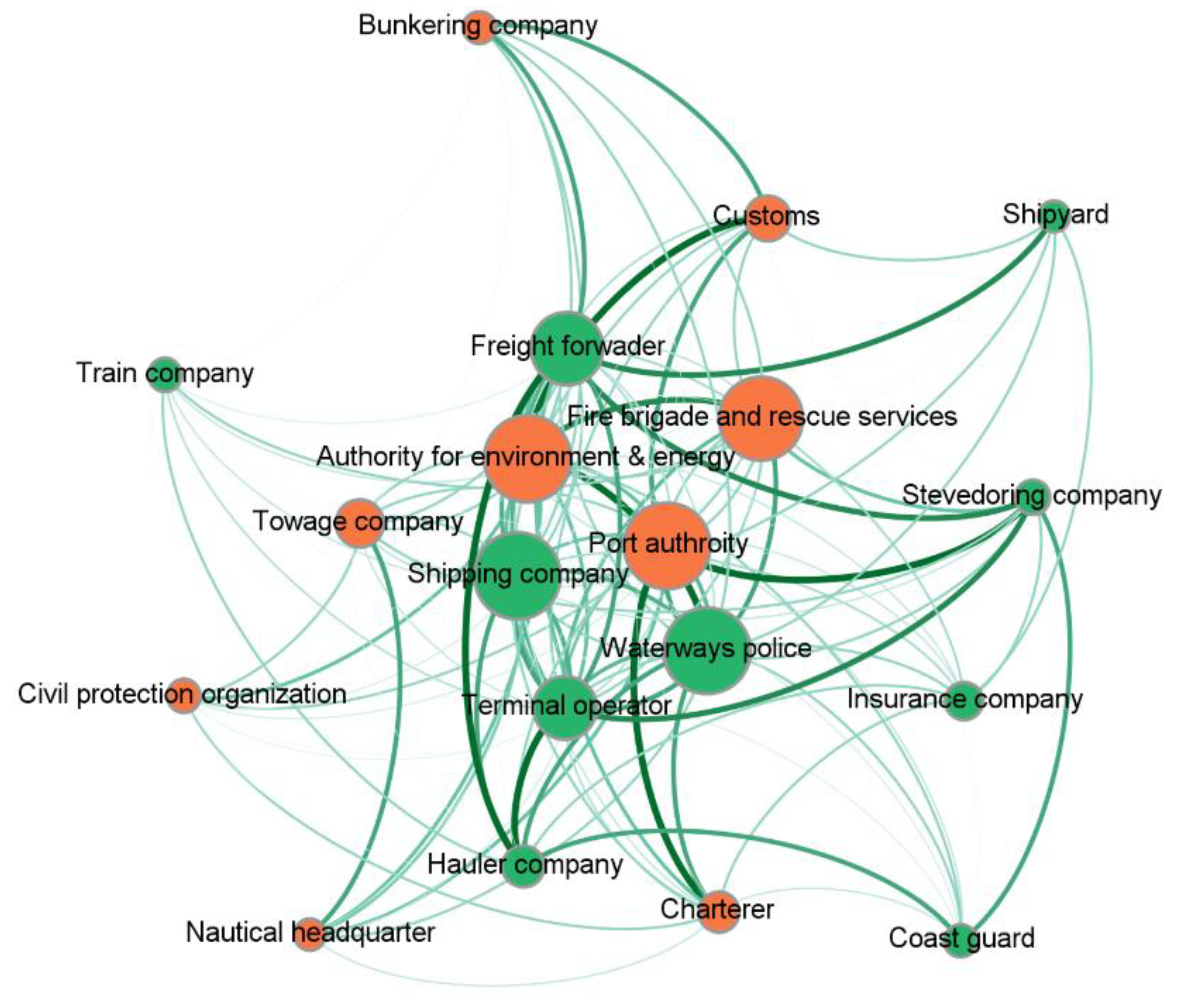
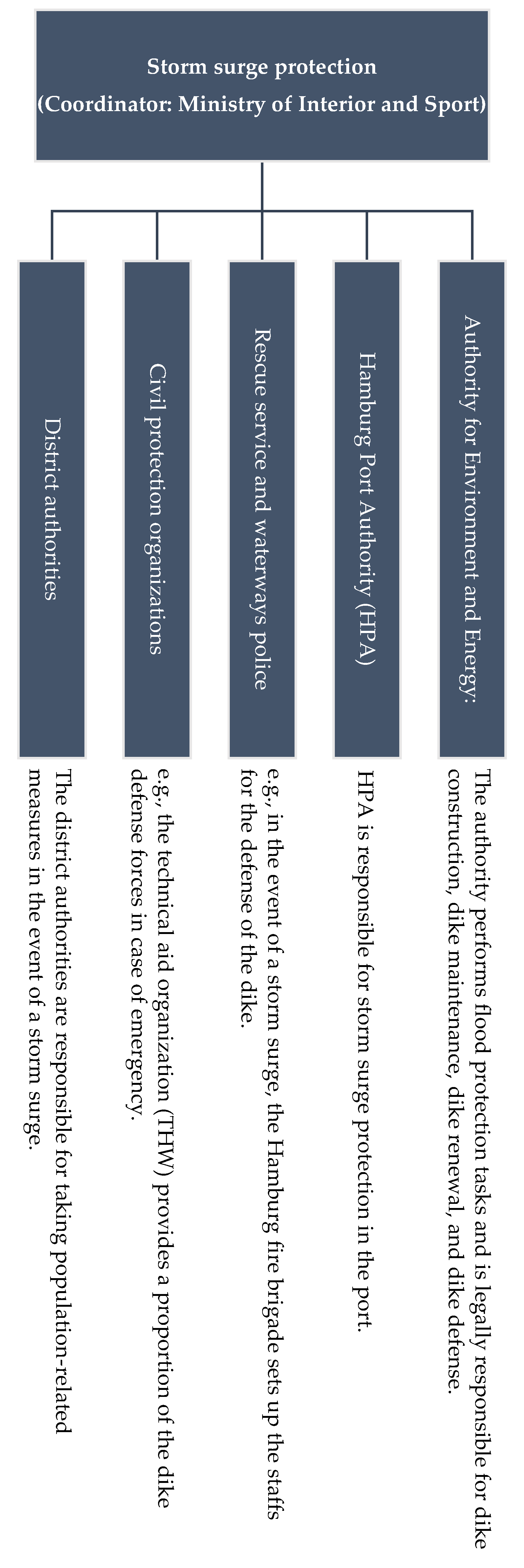

| Papers/Scope | Risk Management | Seaport | Stakeholder Analysis | Community Detection |
|---|---|---|---|---|
| Pileggi et al., 2020 [4] |  |  |  |  |
| Wagner, 2017 [11] |  |  |  |  |
| Aaerts et al., 2015 [36] |  |  |  |  |
| Becker et al., 2015 [37] |  |  |  |  |
| Da Cruz et al., 2013 [38] |  |  |  |  |
| Notteboom and Winkelmans, 2007 [13] |  |  |  |  |
| Dooms et al., 2004 [39] |  |  |  |  |
| This work |  |  |  |  |
 : fully fulfilled—
: fully fulfilled— : partially fulfilled—
: partially fulfilled— : not fulfilled.
: not fulfilled.| Stakeholder Category | N/A | Never (0) | Rarely (1) | Sometimes (2) | Very Often (3) | Always (4) |
|---|---|---|---|---|---|---|
| Port authority | □ | □ | □ | □ | □ | □ |
| Authority for Environment and Energy | □ | □ | □ | □ | □ | □ |
| Civil protection organization | □ | □ | □ | □ | □ | □ |
| Fire brigade and rescue services | □ | □ | □ | □ | □ | □ |
| Source Node | Target Node | Intensity Value (1) | Intensity Value (2) |
|---|---|---|---|
| Authority for Environment and Energy | Port authority | 3 | 3 |
| Authority for Environment and Energy | Civil protection organization | 3 | 3 |
| Authority for Environment and Energy | Fire brigade and rescue services | 4 | 4 |
| Authority for Environment and Energy | Waterways police | 4 | 4 |
| # | Target Node | # | Target Node |
|---|---|---|---|
| 1 | Port authority | 11 | Train company |
| 2 | Authority for Environment and Energy | 12 | Customs |
| 3 | Civil protection organization | 13 | Nautical headquarter |
| 4 | Fire brigade and rescue services | 14 | Insurance company |
| 5 | Waterways police | 15 | Charterer |
| 6 | Coast guard | 16 | Stevedoring company |
| 7 | Terminal operator | 17 | Shipyard |
| 8 | Shipping company | 18 | Bunkering company |
| 9 | Towage company | 19 | Hauler company |
| 10 | Freight forwarder |
| Source | Target | Type | Weight |
|---|---|---|---|
| Authority for Environment and Energy | Civil protection organization | Undirected | 3 |
| Authority for Environment and Energy | Waterways police | Undirected | 4 |
| Authority for Environment and Energy | Coast guard | Undirected | 0,5 |
| Authority for Environment and Energy | Terminal operator | Undirected | 3,5 |
| Authority for Environment and Energy | Shipping company | Undirected | 2,5 |
| Network Parameter | Risk Category | Value |
|---|---|---|
| Average degree | Natural disasters | 11 |
| Operational and safety risks | 15.7 | |
| Network diameter | Natural disasters | 3 |
| Operational and safety risks | 2 | |
| Graph density | Natural disasters | 73.3% |
| Operational and safety risks | 87.1% |
| Community 1 | Community 2 |
|---|---|
| Authority for environment | Civil protection organization |
| Customs | Coast guard |
| Fire brigade and rescue services | Insurance company |
| Freight forwarder | Nautical headquarter |
| Terminal operator | Port authority |
| Train company | Shipyard |
| Shipping company | Stevedoring company |
| Waterways police | Towage company |
| Community 1 | Community 2 |
|---|---|
| Coast guard | Authority for environment and energy |
| Freight forwarder | Bunkering company |
| Haulier company | Charterer |
| Insurance company | Civil protection organization |
| Shipping company | Customs |
| Shipyard | Fire brigade and rescue services |
| Stevedoring company | Nautical headquarter |
| Terminal operator | Port authority |
| Train company | Towage company |
| Waterways police |
| # | Stakeholder Group | # | Stakeholder Group |
|---|---|---|---|
| a | Terminal operator | j | Freight forwarder |
| b | Shipping company | k | Police |
| c | Stevedore company | l | Customs |
| d | Port authority | m | Haulier company |
| e | Nautical headquarter | n | Train company |
| f | Authority for environment and energy | o | Airport |
| g | Fire brigades and rescue services | p | Insurance company |
| h | Waterways police | q | Civil protection organization |
| i | Towage company | ||
Publisher’s Note: MDPI stays neutral with regard to jurisdictional claims in published maps and institutional affiliations. |
© 2021 by the authors. Licensee MDPI, Basel, Switzerland. This article is an open access article distributed under the terms and conditions of the Creative Commons Attribution (CC BY) license (https://creativecommons.org/licenses/by/4.0/).
Share and Cite
Nagi, A.; Schroeder, M.; Kersten, W. Risk Management in Seaports: A Community Analysis at the Port of Hamburg. Sustainability 2021, 13, 8035. https://doi.org/10.3390/su13148035
Nagi A, Schroeder M, Kersten W. Risk Management in Seaports: A Community Analysis at the Port of Hamburg. Sustainability. 2021; 13(14):8035. https://doi.org/10.3390/su13148035
Chicago/Turabian StyleNagi, Ayman, Meike Schroeder, and Wolfgang Kersten. 2021. "Risk Management in Seaports: A Community Analysis at the Port of Hamburg" Sustainability 13, no. 14: 8035. https://doi.org/10.3390/su13148035
APA StyleNagi, A., Schroeder, M., & Kersten, W. (2021). Risk Management in Seaports: A Community Analysis at the Port of Hamburg. Sustainability, 13(14), 8035. https://doi.org/10.3390/su13148035







